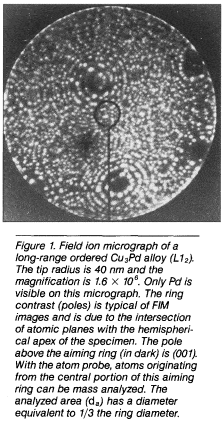Published online by Cambridge University Press: 29 November 2013
The emergence of the field ion microscope, invented by E.W. Müller in 1951, allowed, for the first time, direct observation of metallic materials in real space on an atomic scale. Field ionization of rare gas atoms near the surface of the material allowed production of an atomic resolution image of the material; field evaporation of surface atoms allowed observation into the depth of the sample.
Field ion microscopy (FIM) has produced numerous impressive results, one of them being three-dimensional reconstruction of defect cascades produced by heavy ion irradiation in metals. FIM techniques have also contributed in a spectacular way to the knowledge of the crystallographic structure of grain boundaries. Surface diffusion as well as surface reconstruction phenomena are applications where, again, FIM gave surprisingly detailed information. This overview of applications of FIM in materials science emphasizes recent work. Detailed information and descriptions of earlier work can be found elsewhere.
During the development of FIM techniques, the basic shortcomings of the instrument for investigating metallic alloys were rapidly recognized. In Cu3Pd alloys, for instance, Cu atoms are darkly imaged and therefore appear as vacancies similar to Co atoms in PtCo and Pt3Co. It is thus impossible to distinguish vacancies from solute atoms. This clearly limited the quantitative use of FIM to study short-range

order in dilute alloys or to investigate long-range order (Figure 1). Similarly, in two-phase materials, precipitates often give rise to quite visible contrast. For instance, in nickel-based alloys, aluminum-enriched precipitates appear in bright contrast. It is therefore possible to find the size and also the number density of particles present in the material. However, FIM does not provide any composition data.